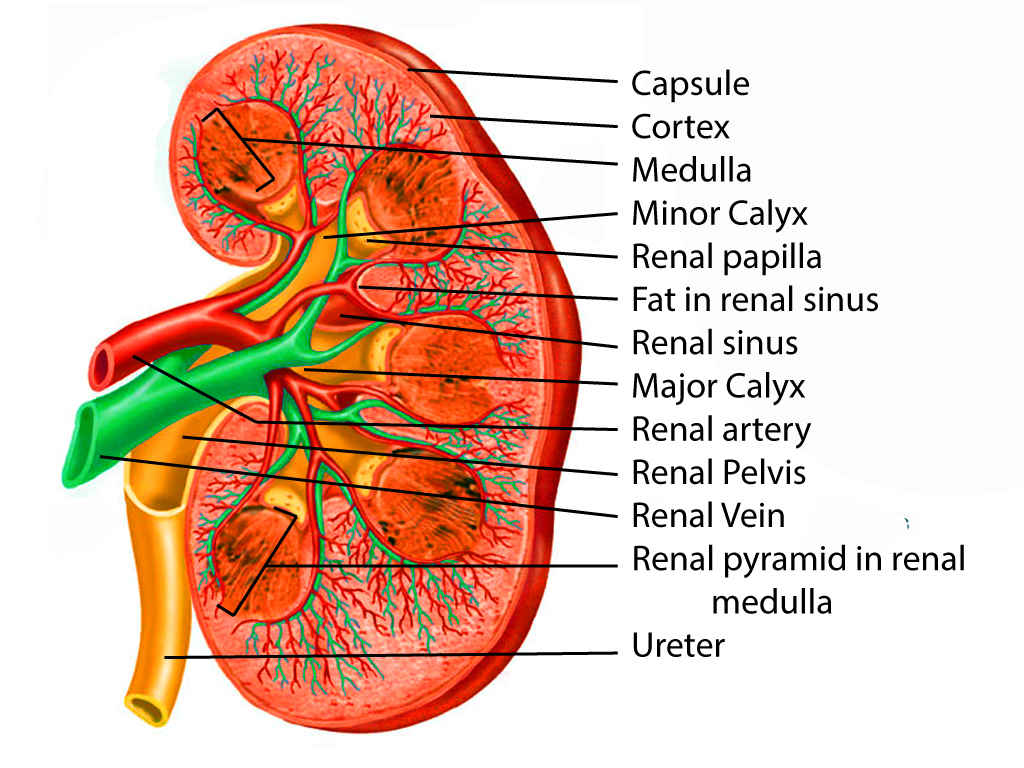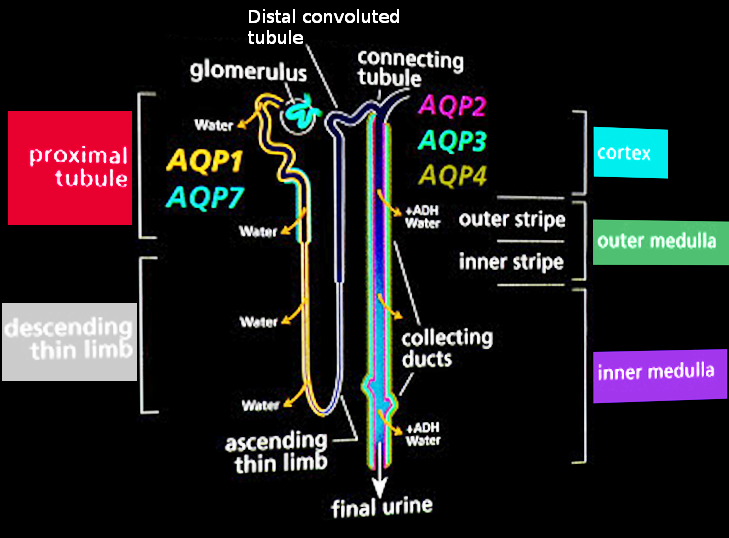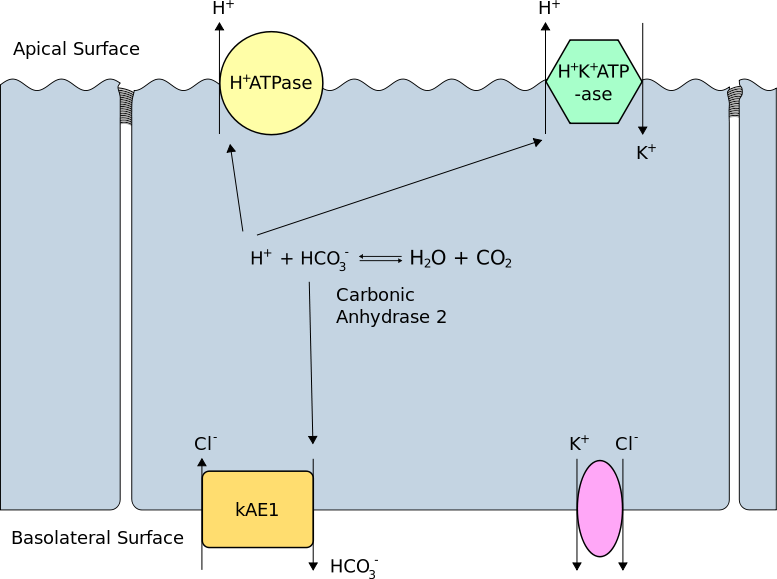[2]
Staruschenko A. Regulation of transport in the connecting tubule and cortical collecting duct. Comprehensive Physiology. 2012 Apr:2(2):1541-84
[PubMed PMID: 23227301]
[3]
Pearce D, Soundararajan R, Trimpert C, Kashlan OB, Deen PM, Kohan DE. Collecting duct principal cell transport processes and their regulation. Clinical journal of the American Society of Nephrology : CJASN. 2015 Jan 7:10(1):135-46. doi: 10.2215/CJN.05760513. Epub 2014 May 29
[PubMed PMID: 24875192]
[4]
Roy A, Al-bataineh MM, Pastor-Soler NM. Collecting duct intercalated cell function and regulation. Clinical journal of the American Society of Nephrology : CJASN. 2015 Feb 6:10(2):305-24. doi: 10.2215/CJN.08880914. Epub 2015 Jan 28
[PubMed PMID: 25632105]
[5]
Weiner ID, Mitch WE, Sands JM. Urea and Ammonia Metabolism and the Control of Renal Nitrogen Excretion. Clinical journal of the American Society of Nephrology : CJASN. 2015 Aug 7:10(8):1444-58. doi: 10.2215/CJN.10311013. Epub 2014 Jul 30
[PubMed PMID: 25078422]
[7]
Krause M, Rak-Raszewska A, Pietilä I, Quaggin SE, Vainio S. Signaling during Kidney Development. Cells. 2015 Apr 10:4(2):112-32. doi: 10.3390/cells4020112. Epub 2015 Apr 10
[PubMed PMID: 25867084]
[8]
Dressler GR. The cellular basis of kidney development. Annual review of cell and developmental biology. 2006:22():509-29
[PubMed PMID: 16822174]
[9]
Pallone TL, Silldorff EP, Turner MR. Intrarenal blood flow: microvascular anatomy and the regulation of medullary perfusion. Clinical and experimental pharmacology & physiology. 1998 Jun:25(6):383-92
[PubMed PMID: 9673811]
[10]
Jamkar AA, Khan B, Joshi DS. Anatomical study of renal and accessory renal arteries. Saudi journal of kidney diseases and transplantation : an official publication of the Saudi Center for Organ Transplantation, Saudi Arabia. 2017 Mar-Apr:28(2):292-297. doi: 10.4103/1319-2442.202760. Epub
[PubMed PMID: 28352010]
[12]
Russell PS, Hong J, Windsor JA, Itkin M, Phillips ARJ. Renal Lymphatics: Anatomy, Physiology, and Clinical Implications. Frontiers in physiology. 2019:10():251. doi: 10.3389/fphys.2019.00251. Epub 2019 Mar 14
[PubMed PMID: 30923503]
[14]
Kassirer JP. Clinical evaluation of kidney function--glomerular function. The New England journal of medicine. 1971 Aug 12:285(7):385-9
[PubMed PMID: 4933769]
[15]
Torres PA, Helmstetter JA, Kaye AM, Kaye AD. Rhabdomyolysis: pathogenesis, diagnosis, and treatment. The Ochsner journal. 2015 Spring:15(1):58-69
[PubMed PMID: 25829882]
[16]
Chitalia V. Muscles Protect the Kidneys. Science translational medicine. 2014 Dec 24:6(268):. pii: 268ec219. doi: 10.1126/scitranslmed.aaa3464. Epub
[PubMed PMID: 29977461]
[17]
Cui Y, Tong A, Jiang J, Wang F, Li C. Liddle syndrome: clinical and genetic profiles. Journal of clinical hypertension (Greenwich, Conn.). 2017 May:19(5):524-529. doi: 10.1111/jch.12949. Epub 2016 Nov 29
[PubMed PMID: 27896928]
[18]
Whyte MP. Carbonic anhydrase II deficiency. Clinical orthopaedics and related research. 1993 Sep:(294):52-63
[PubMed PMID: 8358947]
[19]
Alhuzaim ON, Almohareb OM, Sherbeeni SM. Carbonic Anhydrase II Deficiency in a Saudi Woman. Clinical medicine insights. Case reports. 2015:8():7-10. doi: 10.4137/CCRep.S16897. Epub 2015 Feb 3
[PubMed PMID: 25674028]
Level 3 (low-level) evidence
[20]
Ciszewski S, Jakimów A, Smolska-Ciszewska B. Collecting (Bellini) duct carcinoma: A clinical study of a rare tumour and review of the literature. Canadian Urological Association journal = Journal de l'Association des urologues du Canada. 2015 Sep-Oct:9(9-10):E589-93. doi: 10.5489/cuaj.2932. Epub 2015 Sep 9
[PubMed PMID: 26425219]
[21]
Pal SK, Choueiri TK, Wang K, Khaira D, Karam JA, Van Allen E, Palma NA, Stein MN, Johnson A, Squillace R, Elvin JA, Chmielecki J, Yelensky R, Yakirevich E, Lipson D, Lin DI, Miller VA, Stephens PJ, Ali SM, Ross JS. Characterization of Clinical Cases of Collecting Duct Carcinoma of the Kidney Assessed by Comprehensive Genomic Profiling. European urology. 2016 Sep:70(3):516-21. doi: 10.1016/j.eururo.2015.06.019. Epub 2015 Jul 3
[PubMed PMID: 26149668]
Level 3 (low-level) evidence
[22]
Sui W, Matulay JT, Robins DJ, James MB, Onyeji IC, RoyChoudhury A, Wenske S, DeCastro GJ. Collecting duct carcinoma of the kidney: Disease characteristics and treatment outcomes from the National Cancer Database. Urologic oncology. 2017 Sep:35(9):540.e13-540.e18. doi: 10.1016/j.urolonc.2017.04.010. Epub 2017 May 8
[PubMed PMID: 28495554]
[23]
Kavanagh C, Uy NS. Nephrogenic Diabetes Insipidus. Pediatric clinics of North America. 2019 Feb:66(1):227-234. doi: 10.1016/j.pcl.2018.09.006. Epub
[PubMed PMID: 30454745]
[24]
Hannon MJ, Thompson CJ. The syndrome of inappropriate antidiuretic hormone: prevalence, causes and consequences. European journal of endocrinology. 2010 Jun:162 Suppl 1():S5-12. doi: 10.1530/EJE-09-1063. Epub 2010 Feb 17
[PubMed PMID: 20164214]
[25]
Bitew S, Imbriano L, Miyawaki N, Fishbane S, Maesaka JK. More on renal salt wasting without cerebral disease: response to saline infusion. Clinical journal of the American Society of Nephrology : CJASN. 2009 Feb:4(2):309-15. doi: 10.2215/CJN.02740608. Epub
[PubMed PMID: 19201917]
[26]
Baylis PH. The syndrome of inappropriate antidiuretic hormone secretion. The international journal of biochemistry & cell biology. 2003 Nov:35(11):1495-9
[PubMed PMID: 12824060]
[28]
Epstein M, Calhoun DA. Aldosterone blockers (mineralocorticoid receptor antagonism) and potassium-sparing diuretics. Journal of clinical hypertension (Greenwich, Conn.). 2011 Sep:13(9):644-8. doi: 10.1111/j.1751-7176.2011.00511.x. Epub 2011 Aug 9
[PubMed PMID: 21896143]
[29]
Laing CM, Toye AM, Capasso G, Unwin RJ. Renal tubular acidosis: developments in our understanding of the molecular basis. The international journal of biochemistry & cell biology. 2005 Jun:37(6):1151-61
[PubMed PMID: 15778079]
Level 3 (low-level) evidence
[30]
Chan JC, Scheinman JI, Roth KS. Consultation with the specialist: renal tubular acidosis. Pediatrics in review. 2001 Aug:22(8):277-87
[PubMed PMID: 11483854]
[31]
Goswami RP, Mondal S, Karmakar PS, Ghosh A. Type 3 renal tubular acidosis. Indian journal of nephrology. 2012 Nov:22(6):466-8. doi: 10.4103/0971-4065.106058. Epub
[PubMed PMID: 23439805]
[32]
Feingold KR, Anawalt B, Blackman MR, Boyce A, Chrousos G, Corpas E, de Herder WW, Dhatariya K, Dungan K, Hofland J, Kalra S, Kaltsas G, Kapoor N, Koch C, Kopp P, Korbonits M, Kovacs CS, Kuohung W, Laferrère B, Levy M, McGee EA, McLachlan R, New M, Purnell J, Sahay R, Shah AS, Singer F, Sperling MA, Stratakis CA, Trence DL, Wilson DP, Papadopoulou-Marketou N, Vaidya A, Dluhy R, Chrousos GP. Hyperaldosteronism. Endotext. 2000:():
[PubMed PMID: 25905293]
[33]
Vaidya A, Mulatero P, Baudrand R, Adler GK. The Expanding Spectrum of Primary Aldosteronism: Implications for Diagnosis, Pathogenesis, and Treatment. Endocrine reviews. 2018 Dec 1:39(6):1057-1088. doi: 10.1210/er.2018-00139. Epub
[PubMed PMID: 30124805]
[35]
Smets P, Meyer E, Maddens B, Daminet S. Cushing's syndrome, glucocorticoids and the kidney. General and comparative endocrinology. 2010 Oct:169(1):1-10. doi: 10.1016/j.ygcen.2010.07.004. Epub 2010 Jul 23
[PubMed PMID: 20655918]
Level 2 (mid-level) evidence
[36]
Werth M, Schmidt-Ott KM, Leete T, Qiu A, Hinze C, Viltard M, Paragas N, Shawber CJ, Yu W, Lee P, Chen X, Sarkar A, Mu W, Rittenberg A, Lin CS, Kitajewski J, Al-Awqati Q, Barasch J. Transcription factor TFCP2L1 patterns cells in the mouse kidney collecting ducts. eLife. 2017 Jun 3:6():. pii: e24265. doi: 10.7554/eLife.24265. Epub 2017 Jun 3
[PubMed PMID: 28577314]
Level 2 (mid-level) evidence
[37]
Hajarnis S, Yheskel M, Williams D, Brefort T, Glaudemans B, Debaix H, Baum M, Devuyst O, Patel V. Suppression of microRNA Activity in Kidney Collecting Ducts Induces Partial Loss of Epithelial Phenotype and Renal Fibrosis. Journal of the American Society of Nephrology : JASN. 2018 Feb:29(2):518-531. doi: 10.1681/ASN.2017030334. Epub 2017 Oct 11
[PubMed PMID: 29021386]
[38]
Tingskov SJ, Choi HJ, Holst MR, Hu S, Li C, Wang W, Frøkiær J, Nejsum LN, Kwon TH, Nørregaard R. Vasopressin-Independent Regulation of Aquaporin-2 by Tamoxifen in Kidney Collecting Ducts. Frontiers in physiology. 2019:10():948. doi: 10.3389/fphys.2019.00948. Epub 2019 Aug 9
[PubMed PMID: 31447686]




